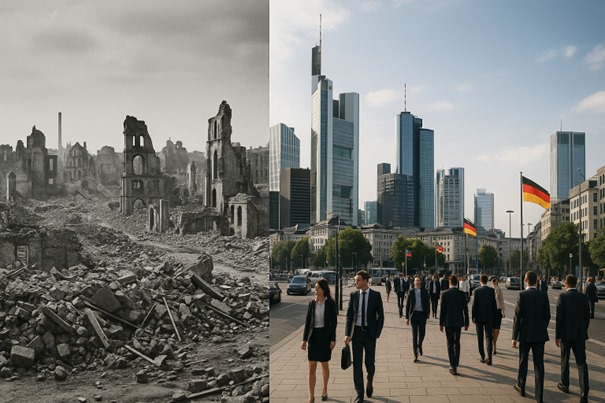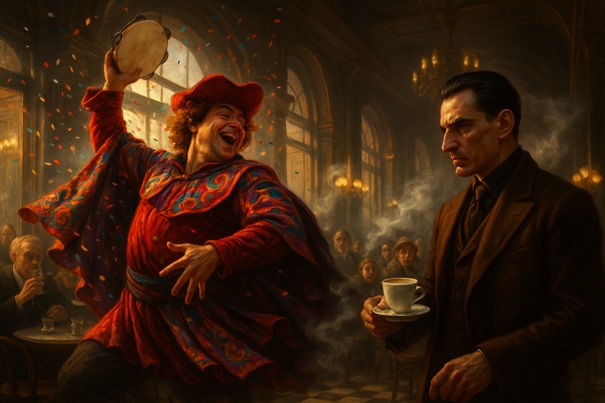Few countries in modern history have experienced as much destruction — and achieved as much recovery — as Germany. After suffering defeat in both World War I and World War II, the country lay devastated economically, socially, and politically. Its cities were bombed, its infrastructure collapsed, its population demoralized.
And yet today, Germany stands not only as Europe's largest economy but also as one of the top five global industrial powers. With a GDP exceeding $4.5 trillion, world-leading exports, and unparalleled engineering prestige, Germany's rise from the ashes is one of the most remarkable economic transformations of the 20th and 21st centuries.
So, how did Germany pull this off? The answer lies in a combination of history, innovation, policy, mindset, and strategy — developed over decades of rebuilding and reform.
1. A Legacy of Industrialization: The Foundation Before the Fall
Long before the wars, Germany had already become a major industrial power. By the early 20th century, it was home to giants like Siemens, Bayer, and Krupp. The country was rich in engineering talent, scientific research, and manufacturing expertise — all of which laid a foundation that would later prove critical for recovery.
Even after WWI, during the chaotic Weimar Republic years (1919–1933), German industry remained active despite hyperinflation and political instability. This deep-rooted industrial base survived the war years and remained embedded in the German economy, ready to be reactivated.
2. The Post-WWII Collapse — and the Marshall Plan
After World War II, Germany was split into East and West, with the West occupied by the U.S., U.K., and France, and the East controlled by the Soviet Union.
West Germany (the Federal Republic of Germany) faced total devastation:
- Industrial output had dropped by over 50%
- Cities like Dresden and Cologne were in ruins
- Millions were displaced or living in poverty
In 1948, however, the U.S. launched the Marshall Plan, a $13 billion aid program designed to help European countries rebuild. West Germany received around $1.4 billion in financial support — but more importantly, it received American backing for economic reform and currency stabilization.
3. The "Wirtschaftswunder" – Germany's Economic Miracle
The 1950s saw what economists now call the Wirtschaftswunder or "economic miracle." Under Chancellor Konrad Adenauer and Economics Minister Ludwig Erhard, West Germany adopted a social market economy — blending free-market capitalism with strong social welfare protections.
Key reforms:
- Introduction of the Deutsche Mark to stop inflation
- Removal of most price controls and rationing
- Reduction in taxes to stimulate business investment
- Protection of private property alongside public safety nets
Between 1950 and 1960, GDP tripled. Industrial output soared. Germany became a leader in steel, automobiles, chemicals, and electrical engineering. By the 1960s, West Germany had become the third-largest economy in the world, behind only the U.S. and USSR.
4. The Role of Discipline, Culture, and Education
German economic success wasn't just about policy — it was about mindset. Post-war Germans approached rebuilding with a unique blend of:
- Work ethic (Pflichtbewusstsein) — a cultural emphasis on duty and discipline
- Technical education — vocational schools (Berufsschule) and apprenticeships
- Long-term planning — rather than speculative finance or fast profits
- Frugality and productivity — reinvesting earnings into infrastructure and R&D
Unlike some Western economies that embraced aggressive consumerism, Germany focused on savings, exports, and manufacturing precision.
5. Export Powerhouse and the "Mittelstand" Model
Germany's economy is famously export-driven. It consistently ranks as one of the top three global exporters, rivaled only by China and the U.S.
But what really powers this export engine?
- High-end manufacturing: cars (BMW, Mercedes-Benz, Volkswagen), machinery, chemicals, medical devices
- Engineering excellence: German products are known for durability and innovation
- The Mittelstand: Thousands of small-to-medium-sized, family-owned companies specializing in niche markets — many of them world leaders in their field.
These companies are agile, deeply embedded in local communities, and focused on quality over quantity.
6. Reunification and Reinvention
In 1990, East and West Germany reunified after the fall of the Berlin Wall. The East had a struggling planned economy, outdated industries, and massive unemployment. Reunification was economically painful and cost hundreds of billions of euros.
However, the West absorbed the shock and managed to modernize the East through infrastructure investment, labor market reform, and integration into the EU economy. While disparities still exist, Germany maintained stability and continued growing throughout the 1990s and 2000s.
7. EU Integration and Global Strategy
Germany played a central role in creating the European Union and the Eurozone, giving it a wider market and stronger political clout. As the anchor of the EU economy, Germany benefits from:
- Open borders for trade and labor
- Euro currency stability (which keeps exports competitive)
- Strategic partnerships with France, the Netherlands, Poland, and beyond
Its global supply chains, diversified trading partners, and diplomatic influence allowed it to weather the 2008 global financial crisis, the COVID-19 pandemic, and now, AI-driven transformations.
8. Modern Challenges – and Why Germany Still Leads
Today, Germany faces serious economic challenges:
- An aging population and labor shortages
- Energy dependency and the post-Russia gas crisis
- Pressure to digitize and embrace AI automation
- Competition from China and global manufacturing shifts
And yet, it remains a top-tier economy because of its resilience, innovation ecosystem, and ability to balance tradition with reinvention.
Government and private institutions are now heavily investing in:
- Green technology and clean energy
- Quantum computing and AI
- Biotech and pharmaceuticals
- Smart manufacturing (Industrie 4.0)
Conclusion: From Defeat to Dominance
Germany's rise from wartime devastation to economic dominance was not an accident — it was a masterclass in long-term vision, institutional stability, cultural discipline, and industrial focus. Despite losing two world wars, being divided for decades, and facing multiple crises, Germany reinvented itself each time without abandoning its core values.
It is, perhaps, the ultimate example that nations don't rise because they avoid hardship — but because they learn how to rebuild through it.



